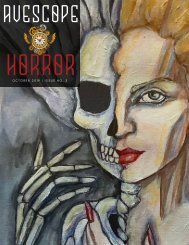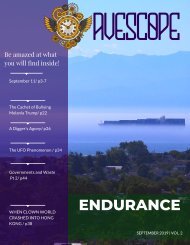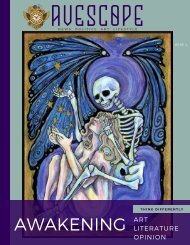Avescope Memento Mori
Avescope Memento Mori. Remember Death. An amazing new magazine about death and remembrance. Art. Photography. History. Fiction. Culture. Poetry. Avescope Memento Mori has it all. This issue is so amazing, it almost makes julienne fries. Thanks to all our contributors: Catherine Clark, Joanna Hatton, Tamsin McKenna-Williams, Catherine Jackson, Blackbird's Photography, Auguste von Osterode, David Simon, Anike Kirsten, Kimm Fernandez, Neva Lee, Tiffany Tong, Matthew Sheetz, Christopher Antim, Karen Lee, LD Towers
Avescope Memento Mori. Remember Death. An amazing new magazine about death and remembrance. Art. Photography. History. Fiction. Culture. Poetry. Avescope Memento Mori has it all. This issue is so amazing, it almost makes julienne fries. Thanks to all our contributors:
Catherine Clark,
Joanna Hatton,
Tamsin McKenna-Williams,
Catherine Jackson,
Blackbird's Photography,
Auguste von Osterode,
David Simon,
Anike Kirsten,
Kimm Fernandez,
Neva Lee,
Tiffany Tong,
Matthew Sheetz,
Christopher Antim,
Karen Lee, LD Towers
You also want an ePaper? Increase the reach of your titles
YUMPU automatically turns print PDFs into web optimized ePapers that Google loves.
to the sexing. In this particular case, the old theory held true.<br />
Another site I worked on had an individual from the earlier<br />
Bronze Age and this showed a different rite: fancy dagger, big<br />
bracelets on the lower arms and some sort of chain – the<br />
purpose of which is lost to me:<br />
The jewellery shown here is not from this particular site but is<br />
typical of what we were getting. The bracelets are really rather<br />
small and it is suggested that they were worn as a rite of<br />
passage: perhaps on hitting puberty, an adolescent female<br />
would wear them to mark this important fact. Conjecture – but<br />
possible.<br />
Also found on site were several large pits containing<br />
deliberately smashed pottery – consisting of a mixture of heavy<br />
coarsewares and finely decorated wares – mixed with the<br />
skeletal remains of calf, goat, deer (evidenced from antler) and<br />
pig. The pig fragments showed signs of butchery. The<br />
destruction of so much pottery in one instance was certainly no<br />
accident: these remains were evidence of ritual feasting, almost<br />
certainly connected to funerary practice. We do the same today<br />
– although we are not generally so destructive at the wakes for<br />
our loved ones.<br />
We don’t know why these people practiced both inhumation<br />
and cremation. It may have been a personal choice, it may have<br />
been linked to their place in society – it may have been because<br />
it was harder to dig a big grave in the frozen soil of a trans-<br />
Alpine winter. We do know that the funeral pyres were<br />
frequently poorly prepared because the cremated bone<br />
fragments are often large enough to be identified by the naked<br />
eye: a well maintained and fuelled fire will produce a hotter<br />
flame, thus creating finer fragments and ashes.<br />
On this particular site I encountered cremations where the<br />
fragments of bone had been collected and buried in a hole with<br />
unburnt bronze jewellery, as well as cases where the ashes and<br />
charcoal had been collected, place in a pot and then buried,<br />
either on their own or with other pots which presumably<br />
contained food or drink. Why do have both types of cremation?<br />
Who knows.<br />
The Roman Province of Raetia et Vindelicia<br />
Links with the classical world stretched back centuries –<br />
through both trade and conflict. Securing Rome’s northern<br />
frontier and the valuable Alpine passes were the pretext for the<br />
invasion by Tiberius and Drusus in 15BC. The inability of the local<br />
Celtic tribes to unite, coupled with their penchant for individual<br />
glory on the battlefield i.e. a lack of discipline - meant that the<br />
Legions had soon pushed as far as the Danube. In time, this<br />
would become the permanent border or Limes.<br />
Romanisation brought big changes to the region: the initial<br />
forts and fortresses of the early days of the advance – as the<br />
province was pacified – often became civilian settlements. The<br />
greatest of these was Augusta Vindelicia, named after the<br />
Emperor Augustus. Augsburg, as it is known today, is located at<br />
a convergence of the rivers Lech and Wertach and was ideally<br />
situated to take advantage of the nearby Alpine passes.<br />
Becoming the capital of the province in about AD120, the city<br />
developed an extensive hinterland. Roman law forbade the<br />
burying the dead within the limits of the town. When we find<br />
burials within Roman settlements – and specifically during the<br />
period when the settlement actually functioned – they are often<br />
neonatals – individuals who died during or soon after childbirth.<br />
They are often found in the foundations of Roman buildings are<br />
typically interpreted as being buried there for ritual purposes.<br />
Roman cemeteries were typically located along the main roads<br />
leading to a settlement or fort. Modern urban development<br />
frequently disturbs the remains of this period, including the<br />
dead. Funerals were primarily a concern of the family.<br />
<strong>Avescope</strong> | 30





